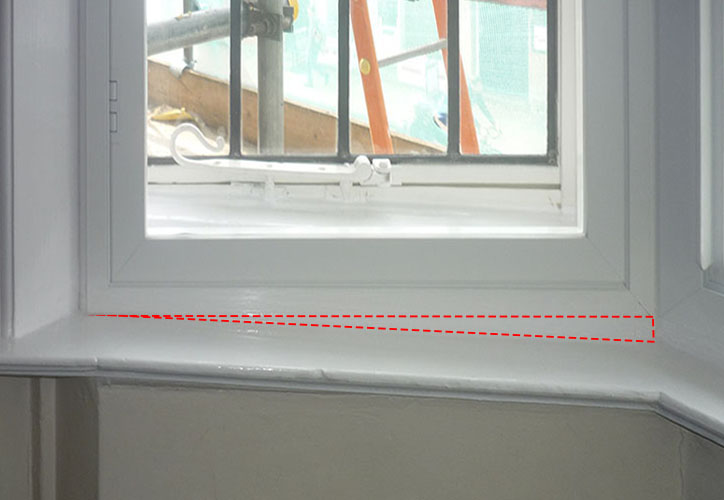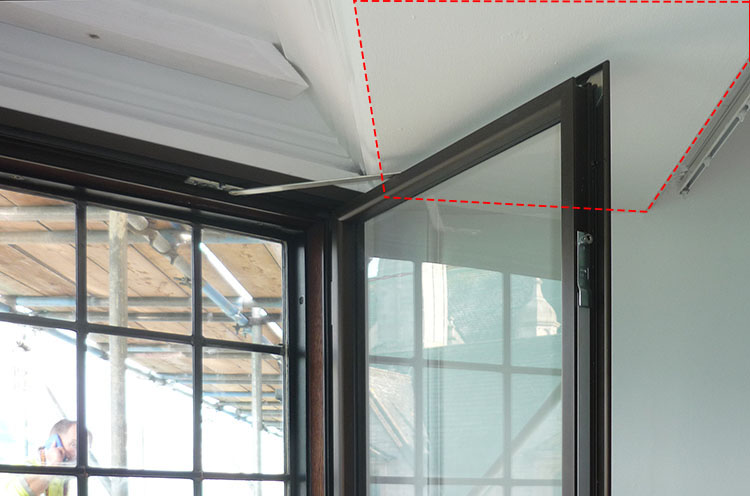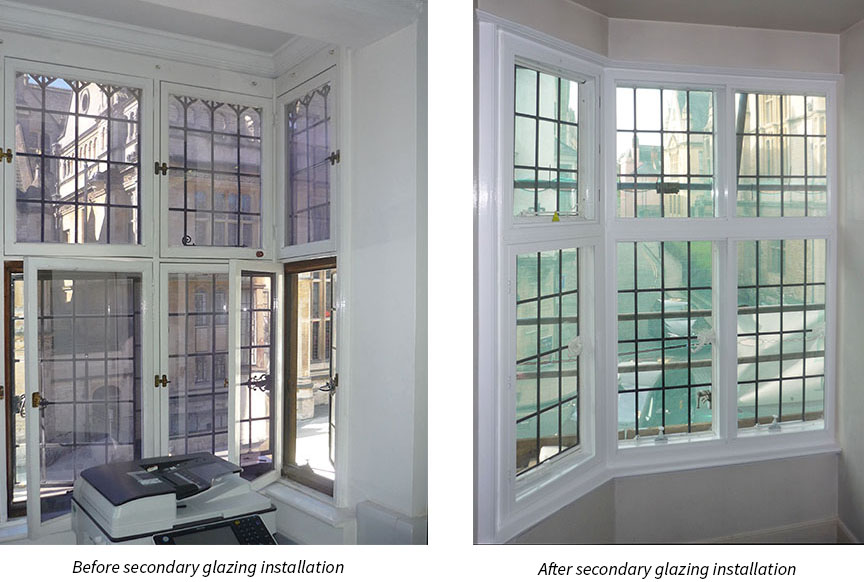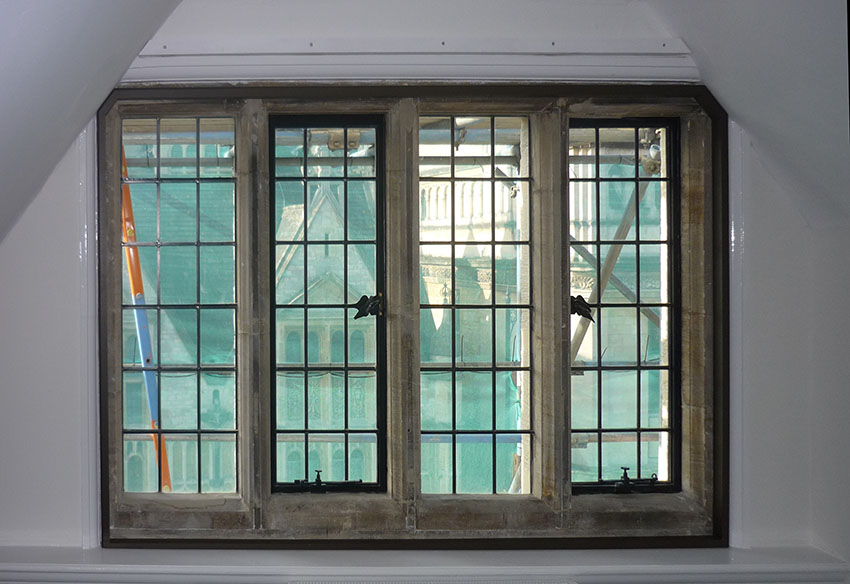This beautiful Grade II mock-Tudor building boasts stone mullioned casement windows with leaded lights as well as oak framed bays with both fixed panels and hinged casement openings. The challenge posed was to treat these eclectic windows with acoustic secondary glazing whilst still retaining their appearance and function. The original primary windows did little to cut out the cacophony of sounds rising from the high street below. Proposals and samples were submitted and successfully passed as acceptable by the Conservation Officer.
The original timber framed bay windows, with many consisting of exposed oak, were treated with a combination of side hung casements, horizontal sliding and lift-out units. Each bay had its own unique proportions and every individual component presented its own splay and fixing irregularities. To ensure a perfect installation, the surveyor had to record every nuance of each opening. These detailed measurements allowed the joinery shop to produce bespoke timber grounds to mitigate all the individual window idiosyncrasies, ensuring optimum fitting and sealing.
This attention to detail ensures an effective acoustic secondary glazing installation. Large tolerances encountered in many other systems with excessive gaps between the secondary unit and the fabric of the building, even if packed, will inevitably reduce the effectiveness and performance of the overall installation and often rely on flimsy plastic trims to complete the installation.
 Raked and angled reveals
To ensure that the windows retained their function, a range of different styles were specified. A few of the bays presented with the additional challenge of physical obstructions such as internal beams. In these cases, care was taken during the survey to ensure that the units were designed in such a way that their operation was not impeded by these restrictive elements, allowing full clearance when opening the units.
Raked and angled reveals
To ensure that the windows retained their function, a range of different styles were specified. A few of the bays presented with the additional challenge of physical obstructions such as internal beams. In these cases, care was taken during the survey to ensure that the units were designed in such a way that their operation was not impeded by these restrictive elements, allowing full clearance when opening the units.
 Internal beams
The majority of the bays consisted of unpainted oak timber frames; so to blend aesthetically with the primary windows, the aluminium extrusions used to make the secondary units were produced in a bronze anodised finish.
An adjacent building with very similar windows also required secondary glazing. However, the primary windows in the smaller of the buildings had original white softwood frames. Many of the windows had timber framed secondary glazing installed which was acoustically and thermally inefficient. This was removed and the primary windows renovated. New white powder coated aluminium secondary glazing was manufactured and installed. Careful design and attention to detail has ensured that the new installation blends seamlessly with the primary window sight lines and colour. The optimal fit achieved through the bespoke nature of the secondary glazing has resulted in a substantial improvement in the interior environment, whilst still maintaining the existing refurbished period primary windows.
Internal beams
The majority of the bays consisted of unpainted oak timber frames; so to blend aesthetically with the primary windows, the aluminium extrusions used to make the secondary units were produced in a bronze anodised finish.
An adjacent building with very similar windows also required secondary glazing. However, the primary windows in the smaller of the buildings had original white softwood frames. Many of the windows had timber framed secondary glazing installed which was acoustically and thermally inefficient. This was removed and the primary windows renovated. New white powder coated aluminium secondary glazing was manufactured and installed. Careful design and attention to detail has ensured that the new installation blends seamlessly with the primary window sight lines and colour. The optimal fit achieved through the bespoke nature of the secondary glazing has resulted in a substantial improvement in the interior environment, whilst still maintaining the existing refurbished period primary windows.
 In addition to the challenges of Tudor style bays, the project also required the sympathetic treatment of original stone mullioned primaries. Bespoke timber grounds together with shaped horizontal sliding units have resulted in an effective acoustic installation. These units were manufactured in bronze anodised aluminium to seamlessly blend in with the old.
In addition to the challenges of Tudor style bays, the project also required the sympathetic treatment of original stone mullioned primaries. Bespoke timber grounds together with shaped horizontal sliding units have resulted in an effective acoustic installation. These units were manufactured in bronze anodised aluminium to seamlessly blend in with the old.
 The secondary timber subframe was first installed to accommodate the irregularities of the opening and allow the aluminium frames to be neatly introduced
The whole project has been given the seal of approval by the Conservation Officer responsible for protecting another irreplaceable building.
The secondary timber subframe was first installed to accommodate the irregularities of the opening and allow the aluminium frames to be neatly introduced
The whole project has been given the seal of approval by the Conservation Officer responsible for protecting another irreplaceable building.
 Raked and angled reveals
To ensure that the windows retained their function, a range of different styles were specified. A few of the bays presented with the additional challenge of physical obstructions such as internal beams. In these cases, care was taken during the survey to ensure that the units were designed in such a way that their operation was not impeded by these restrictive elements, allowing full clearance when opening the units.
Raked and angled reveals
To ensure that the windows retained their function, a range of different styles were specified. A few of the bays presented with the additional challenge of physical obstructions such as internal beams. In these cases, care was taken during the survey to ensure that the units were designed in such a way that their operation was not impeded by these restrictive elements, allowing full clearance when opening the units.
 Internal beams
The majority of the bays consisted of unpainted oak timber frames; so to blend aesthetically with the primary windows, the aluminium extrusions used to make the secondary units were produced in a bronze anodised finish.
An adjacent building with very similar windows also required secondary glazing. However, the primary windows in the smaller of the buildings had original white softwood frames. Many of the windows had timber framed secondary glazing installed which was acoustically and thermally inefficient. This was removed and the primary windows renovated. New white powder coated aluminium secondary glazing was manufactured and installed. Careful design and attention to detail has ensured that the new installation blends seamlessly with the primary window sight lines and colour. The optimal fit achieved through the bespoke nature of the secondary glazing has resulted in a substantial improvement in the interior environment, whilst still maintaining the existing refurbished period primary windows.
Internal beams
The majority of the bays consisted of unpainted oak timber frames; so to blend aesthetically with the primary windows, the aluminium extrusions used to make the secondary units were produced in a bronze anodised finish.
An adjacent building with very similar windows also required secondary glazing. However, the primary windows in the smaller of the buildings had original white softwood frames. Many of the windows had timber framed secondary glazing installed which was acoustically and thermally inefficient. This was removed and the primary windows renovated. New white powder coated aluminium secondary glazing was manufactured and installed. Careful design and attention to detail has ensured that the new installation blends seamlessly with the primary window sight lines and colour. The optimal fit achieved through the bespoke nature of the secondary glazing has resulted in a substantial improvement in the interior environment, whilst still maintaining the existing refurbished period primary windows.
 In addition to the challenges of Tudor style bays, the project also required the sympathetic treatment of original stone mullioned primaries. Bespoke timber grounds together with shaped horizontal sliding units have resulted in an effective acoustic installation. These units were manufactured in bronze anodised aluminium to seamlessly blend in with the old.
In addition to the challenges of Tudor style bays, the project also required the sympathetic treatment of original stone mullioned primaries. Bespoke timber grounds together with shaped horizontal sliding units have resulted in an effective acoustic installation. These units were manufactured in bronze anodised aluminium to seamlessly blend in with the old.
 The secondary timber subframe was first installed to accommodate the irregularities of the opening and allow the aluminium frames to be neatly introduced
The whole project has been given the seal of approval by the Conservation Officer responsible for protecting another irreplaceable building.
The secondary timber subframe was first installed to accommodate the irregularities of the opening and allow the aluminium frames to be neatly introduced
The whole project has been given the seal of approval by the Conservation Officer responsible for protecting another irreplaceable building.
- Date
- Category
- Treat Of The Month